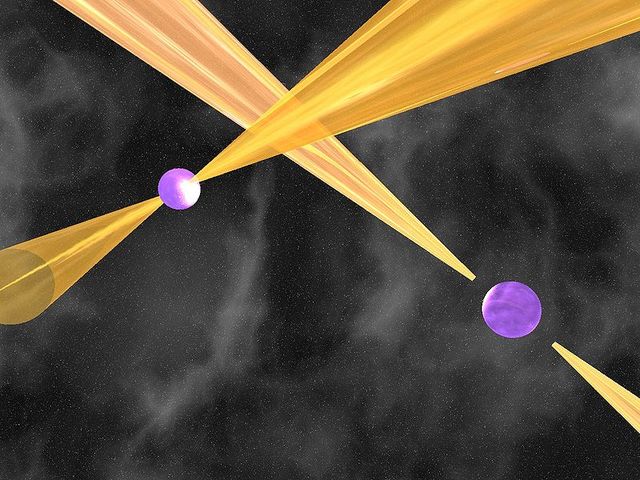
Spiral Dance of Black Holes This illustration shows the merger of two black holes and the gravitational waves that ripple outward as the black holes spiral toward each other. The black holes—which represent those detected by LIGO on Dec. 26, 2015—were 14 and 8 times the mass of the sun, until they merged, forming a single black hole 21 times the mass of the sun. In reality, the area near the black holes would appear highly warped, and the gravitational waves would be difficult to see directly. Image credit: LIGO/T. Pyle
What are Gravitational Waves?
Gravitational waves are 'ripples' in space-time caused by some of the most violent and energetic processes in the Universe. Albert Einstein predicted the existence of gravitational waves in 1916 in his general theory of relativity. Einstein's mathematics showed that massive accelerating objects (things like neutron stars or black holes orbiting each other) would disrupt space-time in such a way that 'waves' of undulating space-time would propagate in all directions away from the source. These cosmic ripples would travel at the speed of light, carrying with them information about their origins, as well as clues to the nature of gravity itself.
The strongest gravitational waves are produced by cataclysmic events such as colliding black holes, supernovae (massive stars exploding at the end of their lifetimes), and colliding neutron stars. Other gravitational waves are predicted to be caused by the rotation of neutron stars that are not perfect spheres, and possibly even the remnants of gravitational radiation created by the Big Bang.
The animation below illustrates how gravitational waves are emitted by two neutron stars as they orbit each other and then coalesce (credit: NASA/Goddard Space Flight Center). Note that gravitational waves themselves are invisible. They are made visible here to illustrate their propagation away from the source.
Though Einstein predicted the existence of gravitational waves in 1916, the first proof of their existence didn't arrive until 1974. In that year, two astronomers, Russell Hulse and Joseph Taylor, using the Arecibo Radio Observatory in Puerto Rico discovered a binary pulsar 21000 light years from Earth. This was exactly the type of system that general relativity predicted should radiate gravitational waves. Knowing that the system could be studied to test Einstein's prediction, Taylor and two colleagues (Joel Weisberg and Lee Fowler) began tracking the radio emissions from the stars to measure how their orbital period changed over time. After just four years, they first reported seeing a change in the period that verified that the stars were getting closer to each other at the rate predicted by general relativity (GR) if they were radiating gravitational waves (the rate predicted by GR agreed with the observed rate to within one half of one percent). In 1993, Hulse and Taylor would receive the Nobel Prize in Physics "for the discovery of a new type of pulsar, a discovery that has opened up new possibilities for the study of gravitation".

Artist's Impression of a Binary Pulsar. (Credit: Michael Kramer, Jodrell Bank, University of Manchester)
Since then, many astronomers have studied pulsar radio-emissions (pulsars are neutron stars that emit beams of radio waves) and found similar effects, further confirming the existence of gravitational waves. But these confirmations had always come indirectly, requiring that one infer the existence of gravitational waves.
All of this changed on September 14, 2015 when U.S. National Science Foundation Laser Interferometer Gravitational-wave Observatory (NSF LIGO) physically sensed the undulations in spacetime caused by gravitational waves generated by two colliding black holes 1.3 billion light-years away. NSF LIGO's first detection will go down in history as one of humanity's greatest scientific achievements.
While the processes that generate measurable gravitational waves are among the most energetic and violent the Universe has to offer, by the time the waves reach Earth millions or billions of light years away, they are thousands of billions of times smaller. In fact, by the time gravitational waves from LIGO's first detection reached us, the amount of space-time wobbling they generated was 10,000 times smaller than the nucleus of an atom! LIGO was designed to make such inconceivable, exquisitely small measurements. To learn how LIGO achieves this seemingly impossible task, visit LIGO's Interferometer.




